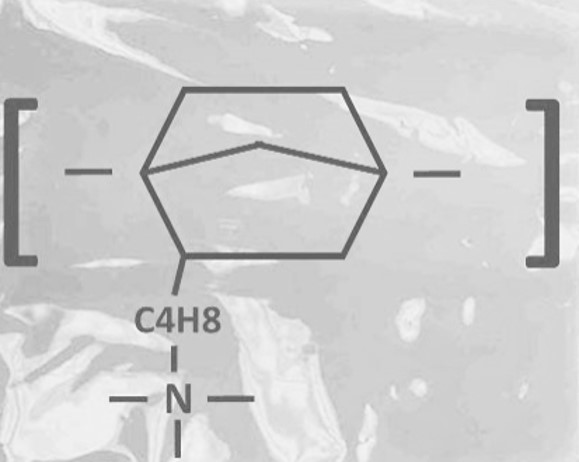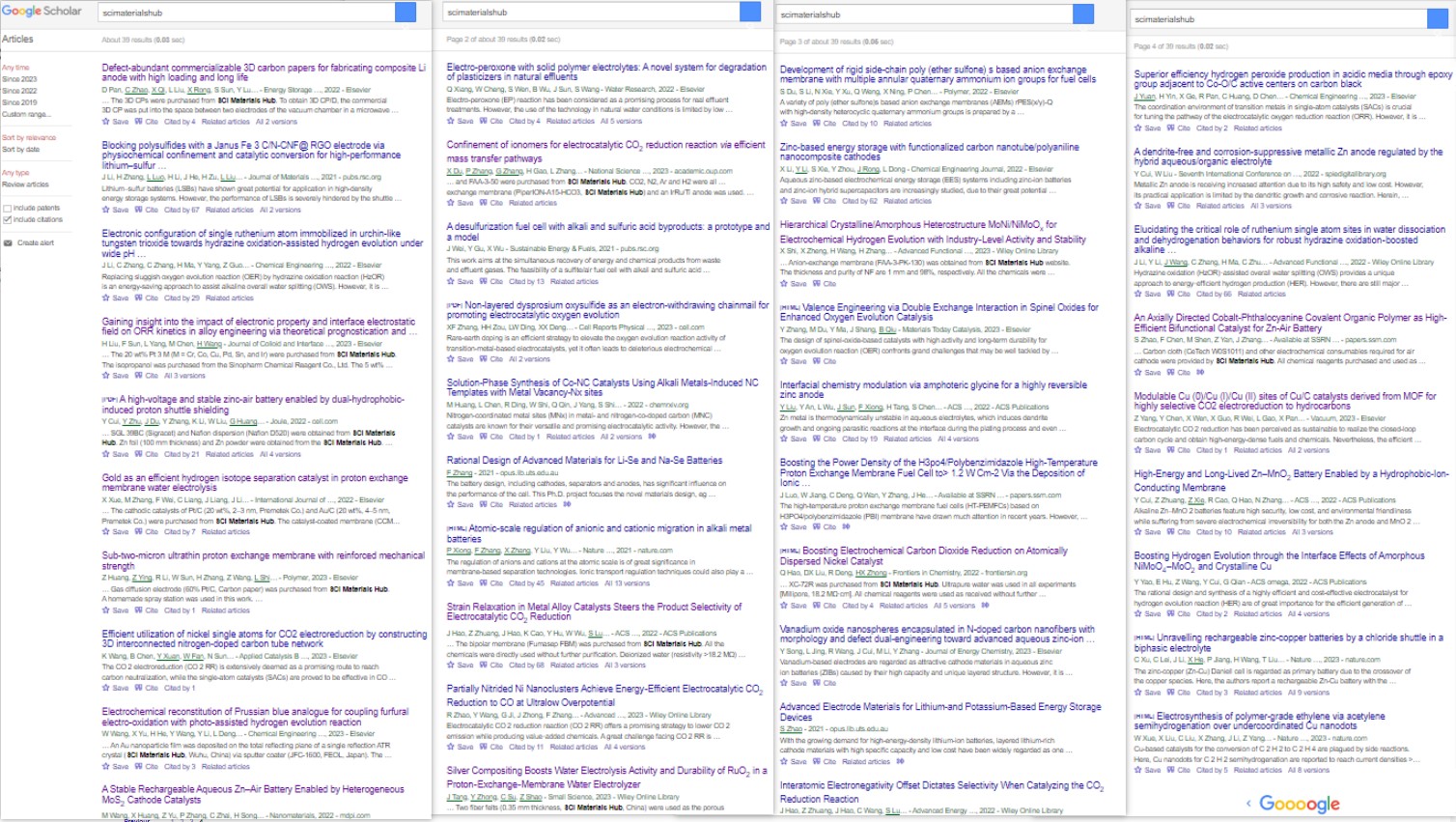
The Xion Pention-AEM-18 membrane is a composite AEM that uses the poly(norbornene) based resin and has an ion exchange capacity of 3.4 to 3.6 mequiv/g. Pention anion exchange membranes offer excellent mechanical strength and stability to a wide variety of chemistries. These particular AEMs depending on their thickness and crosslinking degree have demonstrated up to 9 A/cm2 current densities (or >3 W/cm2 power densities) in alkaline fuel cells with excellent durability and lifetime [based on the recent jointly conducted study between NREL, University of South Carolina, and Georgia Institute of Technology].
The stated electrochemical performance data is for reference only and depending on the MEA, CCM or GDE manufacturing method, used membrane thickness, testing hardware design and components used in the test hardware, and operational parameters (temperature, pressure, reactant flow rates, etc.), those values may or may not be attained.
SCI Materials Hub currently provides Composite Pention-18-5CL series anion exchange membrane sheets in 5, 10, 20, 30 and 50μm thicknesses and 5x5cm, 10x10cm, and 15x15cm sizes. Image on the bottom shows the chemical composition of the anion exchange resin used to manufacture Xion Composite Pention membranes.

The Xion Composite Pention-AEM-18 series can be used in fuel cells, electrolyzers, electrodialysis, redox flow batteries, electrochemical compressors, and a wide variety of other devices. Composite Pention AEMs are currently offered with 5% or 15% crosslinking levels.
XION Composite PENTION Membranes are ultra-thin, ultra-strong, and provide ultra-high performance while demonstrating highly stable performance as reinforced anion exchange membranes (AEM). The ionomer structure contains a poly(norbornene) backbone with quaternary ammonium functional groups. A reinforcement layer is integrated into the structure of the membrane to provide enhanced mechanical properties. The enhanced mechanical properties as free-standing membranes, providing higher ionic conductance without sacrificing strength.
-High anionic conductivity
-Great chemical stability at low and high temperatures
-Ultra-thin membranes with excellent mechanical strength
The membrane is delivered in dry form with the counter anion being either in bromide or chloride. Depending on application and cell design, assembling is possible in dry form (without pretreatment) or wet form.
For standard alkaline fuel cell / electrolysis applications, the membrane should be converted into OH-form by treating it with 0.5 – 1.0 M NaOH or KOH solution: Put the membrane sample in an aqueous solution of 0.5 – 1.0 M NaOH or KOH for at least 24 h at 20°C – 30°C. After rinsing with demineralised water (pH ~ 7) the membrane is ready to use. Use closed container to avoid CO2 contamination (carbonate formation that may affect conductivity). The membrane in OH-form must be stored under wet / humidified and CO2-free conditions, avoid drying out of the membrane in OH-form. Long-term storage in dry conditions should be preferably done in carbonate, Cl- or Br-form.
For electrochemical CO2 reduction applications, the anion exchange membrane should be converted to the carbonate or bicarbonate form by treating the membrane initially with 0.1 to 0.5 M KOH or NaOH solution and then with 0.1 to 0.5 M water soluble carbonate or bicarbonate salt solutions (such as potassium carbonate or potassium bicarbonate that is dissolved in de-ionized water or distilled water). Fully submerging the anion exchange membrane into KOH or NaOH solution for 6 to 12 hours and then to the desired carbonate or bicarbonate salt solution for a period of 48-72 hours would be sufficient to fully convert the membrane into either carbonate or bicarbonate form. After rinsing the membrane (which is in the carbonate form) with deionized water or distilled water, it can be assembled inside the electrochemical setup for electrochemical CO2 reduction experiments. While the submersion of the membrane into the KOH or NaOH can be skipped, for such situations, a longer submersion time may be required in order to fully convert the membrane to carbonate or bicarbonate form. Initial conversion to OH- form significantly improves the carbonate ion exchange process due to expanded pore sizes.
For other electrochemical (electrodialysis, desalination, electro-electrodialysis, reverse electrodialysis, acid recovery, salt splitting, etc.) and non-electrochemical applications, the membrane should be converted into the anionic form that is relevant for the intended application. For example, if the application is requiring the Cl- anions to be transferred through the membrane, then this anion exchange membrane needs to be converted into the Cl- form. In order to convert this membrane into Cl- form, it needs to be submerged into a 1-2 M salt solution of NaCl or KCl (dissolved in deionized water) for a period of 24-72 hours and then rinsed with deionized water to remove the excess salt from the membrane surface. Or if the intended application is requiring to transfer sulfate anions, then this anion exchange membrane needs to be converted into the sulfate form prior to its assembly into the cell. A neutral salt solution of Na2SO4 or K2SO4 would usually be sufficient to achieve the full conversion of membrane into the sulfate form after fully submerging the membrane into the salt solution for 24-72 hours at room temperature.
If you have any concerns about storage, chemical stability, pre-treatment or before proceeding, please feel free to contact us for further information.
| Xion AEM-Pention-18-5CL (5, 10, 20 30, 50μm) Anion Exchange Membrane - SCI Materials Hub | |
| Membrane Thickness | 5, 10, 20, 30, 50μm |
| Polymer Type | Poly(norbornene) based backbone |
| Functional Group | Quaternary ammonium cationic groups as functional groups |
| Counter ion | Halide (Cl- or Br-) |
| Mechanical Reinforcement | Yes, ePTFE (also known as expanded PTFE) is the mechanical reinforcement substrate |
| Self-supporting Membrane | No |
| Ion Exchange Capacity | 3.4 - 3.6 meq/g |
| Ionic Conductivity | Undisclosed |
| Molecular Weight | Undisclosed |
| Water Uptake | Undisclosed |
| Melting Point | Undisclosed |
| Decomposition Point | Undisclosed |
| pH range | 1 - 14. With alkaline electrolytes, concentrations greater than 1 - 1.5M should not be used with this membrane. |
For international orders, please ask us for quotes via
Email: contact@scimaterials.cn
Tel: +86 130-0303-8751 / +86 156-0553-2352
Wechat: 15375698751
| SCI Materials Hub - XION Anion Exchange Membranes | ||||||||
| ?Description | Thickness | Product Code | Price (USD$) | Remarks | ||||
| 5*5cm | 10*10cm | 15*15cm | 20*20cm | More size | ||||
| AEM-Durion-G2 | 5μm | 1801001 | LMW series | |||||
| 10μm | 1801002 | |||||||
| 20μm | 1801003 | |||||||
| 30μm | 1801004 | |||||||
| AEM-Pention-72-5CL | 5μm | 1801005 | 72 series 5% Cross-linking | |||||
| 10μm | 1801006 | |||||||
| 20μm | 1801007 | |||||||
| 30μm | 1801008 | |||||||
| 50μm | 1801009 | |||||||
| AEM-Pention-72-15CL | 5μm | 1801010 | 72 series 15% Cross-linking | |||||
| 10μm | ?1801011 | |||||||
| 20μm | 1801012 | |||||||
| 30μm | 1801013 | |||||||
| AEM-Pention-35-5CL | 5μm | 1801014 | 35 series 5% Cross-linking | |||||
| 10μm | 1801015 | |||||||
| 20μm | 1801016 | |||||||
| 30μm | 1801017 | |||||||
| 50μm | 1801018 | |||||||
| AEM-Pention-35-15CL | 5μm | 1801019 | 35 series 15% Cross-linking | |||||
| 10μm | 1801020 | |||||||
| 20μm | 1801021 | |||||||
| 30μm | 1801022 | |||||||
| AEM-Pention-18-5CL | 5μm | 1801023 | 18 series 5% Cross-linking | |||||
| 10μm | 1801024 | |||||||
| 20μm | 1801025 | |||||||
| 30μm | 1801026 | |||||||
| 50μm | 1801027 | |||||||
| AEM-Pention-18-15CL | 5μm | 1801028 | 18 series 15% Cross-linking | |||||
| 10μm | 1801029 | |||||||
| 20μm | 1801030 | |||||||
| 30μm | 1801031 | |||||||
| AEM-Dappion | 5μm | 1801032 | Dappion series | |||||
| 10μm | 1801033 | |||||||
| 20μm | 1801034 | |||||||
| 30μm | 1801035 | |||||||
| SCI Materials Hub Is Committed to Offering The Best Price & Customer Services! | ||||||||
* Worldwide shipping via DHL, SF-Express & other requested carriers.
* Bulk quantities with discount upon request.
* Payments via Bank Transfer, Paypal, Credit card (via Taobao), Alipay, Wechat-pay are accepted.
Partial references citing our materials (from Google Scholar)

Carbon Dioxide Reduction
1. ACS Nano Strain Relaxation in Metal Alloy Catalysts Steers the Product Selectivity of Electrocatalytic CO2 Reduction
The bipolar membrane (Fumasep FBM) in this paper was purchased from SCI Materials Hub, which was used in rechargeable Zn-CO2 battery tests. The authors reported a strain relaxation strategy to determine lattice strains in bimetal MNi alloys (M = Pd, Ag, and Au) and realized an outstanding CO2-to-CO Faradaic efficiency of 96.6% with outstanding activity and durability toward a Zn-CO2 battery.
2. Front. Chem. Boosting Electrochemical Carbon Dioxide Reduction on Atomically Dispersed Nickel Catalyst
In this paper, Vulcan XC-72R was purchased from SCI Materials Hub. Vulcan XC 72R carbon is the most common catalyst support used in the anode and cathode electrodes of Polymer Electrolyte Membrane Fuel Cells (PEMFC), Direct Methanol Fuel Cells (DMFC), Alkaline Fuel Cells (AFC), Microbial Fuel Cells (MFC), Phosphoric Acid Fuel Cells (PAFC), and many more!
3. Adv. Mater. Partially Nitrided Ni Nanoclusters Achieve Energy-Efficient Electrocatalytic CO2 Reduction to CO at Ultralow Overpotential
An AEM membrane (Sustainion X37-50 Grade RT, purchased from SCI Materials Hub) was activated in 1 M KOH for 24 h, washed with ultra-purity water prior to use.
4. Adv. Funct. Mater. Nanoconfined Molecular Catalysts in Integrated Gas Diffusion Electrodes for High-Current-Density CO2 Electroreduction
In this paper (Supporting Information), an anion exchanged membrane (Fumasep FAB-PK-130 obtained from SCI Materials Hub (www.scimaterials.cn)) was used to separate the catholyte and anolyte chambers.
SCI Materials Hub: we also recommend our Fumasep FAB-PK-75 for the use in a flow cell.
5. Appl. Catal. B Efficient utilization of nickel single atoms for CO2 electroreduction by constructing 3D interconnected nitrogen-doped carbon tube network
In this paper, the Nafion 117 membrane was obtained from SCI Materials Hub.
In this paper, Proton exchange membrane (Nafion 117), Nafion D520, and Toray 060 carbon paper were purchased from SCI Materials Hub.
7. National Science Review Confinement of ionomer for electrocatalytic CO2 reduction reaction via efficient mass transfer pathways
An anion exchange membrane (PiperION-A15-HCO3) was obtained from SCI Materials Hub.
8. Catalysis Communications Facilitating CO2 electroreduction to C2H4 through facile regulating {100} & {111} grain boundary of Cu2O
Carbon paper (TGPH060), membrane solution (Nafion D520), and ionic membrane (Nafion N117) were obtained from Wuhu Eryi Material Technology Co., Ltd (a company under SCI Materials Hub).
Batteries
1. J. Mater. Chem. A Blocking polysulfides with a Janus Fe3C/N-CNF@RGO electrode via physiochemical confinement and catalytic conversion for high-performance lithium–sulfur batteries
Graphene oxide (GO) in this paper was obtained from SCI Materials Hub. The authors introduced a Janus Fe3C/N-CNF@RGO electrode consisting of 1D Fe3C decorated N-doped carbon nanofibers (Fe3C/N-CNFs) side and 2D reduced graphene oxide (RGO) side as the free-standing carrier of Li2S6 catholyte to improve the overall electrochemical performance of Li-S batteries.
This paper used more than 10 kinds of materials from SCI Materials Hub and the authors gave detailed properity comparsion.
The commercial IEMs of Fumasep FAB-PK-130 and Nafion N117 were obtained from SCI Materials Hub.
Gas diffusion layers of GDL340 (CeTech) and SGL39BC (Sigracet) and Nafion dispersion (Nafion D520) were obtained from SCI Materials Hub.
Zn foil (100 mm thickness) and Zn powder were obtained from the SCI Materials Hub.
Commercial 20% Pt/C, 40% Pt/C and IrO2 catalysts were also obtained from SCI Materials Hub.
3. Journal of Energy Chemistry Vanadium oxide nanospheres encapsulated in N-doped carbon nanofibers with morphology and defect dual-engineering toward advanced aqueous zinc-ion batteries
In this paper, carbon cloth (W0S1011) was obtained from SCI Materials Hub. The flexible carbon cloth matrix guaranteed the stabilization of the electrode and improved the conductivity of the cathode.
4. Energy Storage Materials Defect-abundant commercializable 3D carbon papers for fabricating composite Li anode with high loading and long life
The 3D carbon paper (TGPH060 raw paper) were purchased from SCI Materials Hub.
5. Nanomaterials A Stable Rechargeable Aqueous Zn–Air Battery Enabled by Heterogeneous MoS2 Cathode Catalysts
Nafion D520 (5 wt%), and carbon paper (GDL340) were received from SCI-Materials-Hub.
Carbon cloth (W0S1011) and other electrochemical consumables required for air cathode were provided by SCI Materials Hub.
Oxygen Reduction Reaction
1. J. Chem. Eng. Superior Efficiency Hydrogen Peroxide Production in Acidic Media through Epoxy Group Adjacent to Co-O/C Active Centers on Carbon Black
In this paper, Vulcan XC 72 carbon black, ion membrane (Nafion N115, 127 μL), Nafion solution (D520, 5 wt%), and carbon paper (AvCarb GDS 2230 and Spectracarb 2050A-1050) were purchased from SCI Materials Hub.
2. Journal of Colloid and Interface Science Gaining insight into the impact of electronic property and interface electrostatic field on ORR kinetics in alloy engineering via theoretical prognostication and experimental validation
The 20 wt% Pt3M (M = Cr, Co, Cu, Pd, Sn, and Ir) were purchased from SCI Materials Hub. This work places emphasis on the kinetics of the ORR concerning Pt3M (M = Cr, Co, Cu, Pd, Sn, and Ir) catalysts, and integrates theoretical prognostication and experimental validation to illuminate the fundamental principles of alloy engineering.
Water Electrolysis
1. International Journal of Hydrogen Energy Gold as an efficient hydrogen isotope separation catalyst in proton exchange membrane water electrolysis
The cathodic catalysts of Pt/C (20 wt%, 2–3 nm) and Au/C (20 wt%, 4–5 nm) were purchased from SCI Materials Hub.
2. Small Science Silver Compositing Boosts Water Electrolysis Activity and Durability of RuO2 in a Proton-Exchange-Membrane Water Electrolyzer
Two fiber felts (0.35 mm thickness, SCI Materials Hub) were used as the porous transport layers at both the cathode and the anode.
3. Advanced Functional Materials Hierarchical Crystalline/Amorphous Heterostructure MoNi/NiMoOx for Electrochemical Hydrogen Evolution with Industry-Level Activity and Stability
Anion-exchange membrane (FAA-3-PK-130) was obtained from SCI Materials Hub website.
Fuel Cells
1. Polymer Sub-two-micron ultrathin proton exchange membrane with reinforced mechanical strength
Gas diffusion electrode (60% Pt/C, Carbon paper) was purchased from SCI Materials Hub.
Characterization
1. Chemical Engineering Journal Electrochemical reconstitution of Prussian blue analogue for coupling furfural electro-oxidation with photo-assisted hydrogen evolution reaction
An Au nanoparticle film was deposited on the total reflecting plane of a single reflection ATR crystal (SCI Materials Hub, Wuhu, China) via sputter coater.

|
We Provide A Broad Range of Materials, Instruments & Solutions in Advanced Science and Technologies | About Us |



